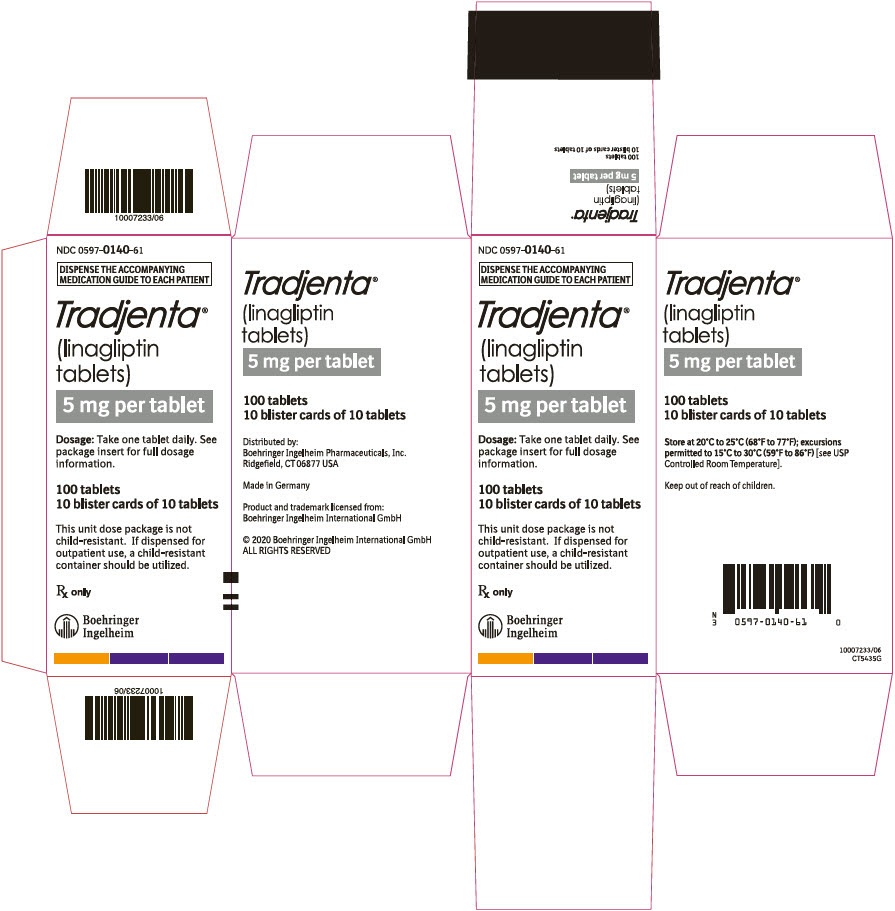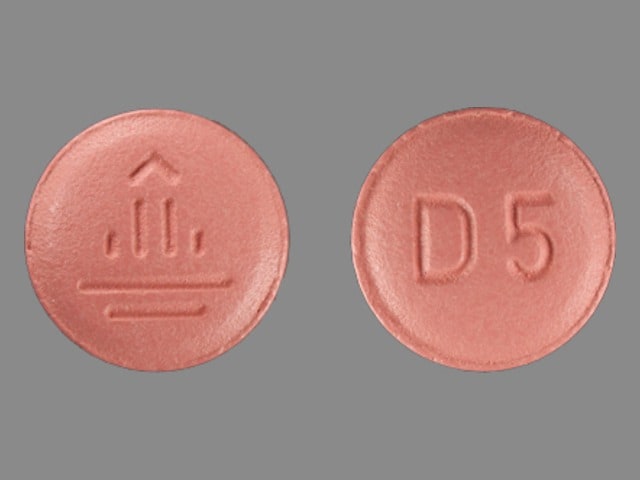Tradjenta
Generic name: linagliptin
Drug class: Dipeptidyl peptidase 4 inhibitors
Medically reviewed by A Ras MD.
What is Tradjenta?
Tradjenta is a prescription medicine used along with diet and exercise to lower blood sugar in adults with type 2 diabetes. Tradjenta is not for people with type 1 diabetes. Tradjenta is not for people with diabetic ketoacidosis (increased ketones in the blood or urine). If you have had pancreatitis in the past, it is not known if you have a higher chance of getting pancreatitis while you take Tradjenta.
It is not known if Tradjenta is safe and effective in children under 18 years of age.
Description
TRADJENTA tablets for oral use contain linagliptin, an inhibitor of the dipeptidyl peptidase-4 (DPP-4) enzyme.
The chemical name of linagliptin is 1H-Purine-2,6-dione, 8-[(3R)-3-amino-1-piperidinyl]-7-(2-butyn-1-yl)-3,7-dihydro-3-methyl-1-[(4-methyl-2-quinazolinyl)methyl]-
The molecular formula is C25H28N8O2 and the molecular weight is 472.54 g/mol. The structural formula is:

Linagliptin is a white to yellowish, not or only slightly hygroscopic solid substance. It is very slightly soluble in water (0.9 mg/mL). Linagliptin is soluble in methanol (ca. 60 mg/mL), sparingly soluble in ethanol (ca. 10 mg/mL), very slightly soluble in isopropanol (<1 mg/mL), and very slightly soluble in acetone (ca. 1 mg/mL).
Each film-coated tablet of TRADJENTA contains 5 mg of linagliptin free base and the following inactive ingredients: mannitol, pregelatinized starch, corn starch, copovidone, and magnesium stearate. In addition, the film coating contains the following inactive ingredients: hypromellose, titanium dioxide, talc, polyethylene glycol, and red ferric oxide.
Mechanism of Action
Linagliptin is an inhibitor of DPP-4, an enzyme that degrades the incretin hormones glucagon-like peptide-1 (GLP-1) and glucose-dependent insulinotropic polypeptide (GIP). Thus, linagliptin increases the concentrations of active incretin hormones, stimulating the release of insulin in a glucose-dependent manner and decreasing the levels of glucagon in the circulation. Both incretin hormones are involved in the physiological regulation of glucose homeostasis. Incretin hormones are secreted at a low basal level throughout the day and levels rise immediately after meal intake. GLP-1 and GIP increase insulin biosynthesis and secretion from pancreatic beta cells in the presence of normal and elevated blood glucose levels. Furthermore, GLP-1 also reduces glucagon secretion from pancreatic alpha-cells, resulting in a reduction in hepatic glucose output.
What is the most important information I should know about Tradjenta?
Serious side effects can happen to people taking Tradjenta, including:
- Inflammation of the pancreas (pancreatitis) which may be severe and lead to death. Certain medical problems make you more likely to get pancreatitis.
Before you start taking Tradjenta, tell your doctor if you have ever had:
- inflammation of your pancreas (pancreatitis)
- a history of alcoholism
- stones in your gallbladder (gallstones)
- high blood triglyceride levels
Stop taking Tradjenta and call your doctor right away if you have pain in your stomach area (abdomen) that is severe and will not go away. The pain may be felt going from your abdomen through to your back. The pain may happen with or without vomiting. These may be symptoms of pancreatitis.
- Heart failure. Heart failure means your heart does not pump blood well enough. Before you start taking Tradjenta, tell your doctor if you have ever had heart failure or have problems with your kidneys. Contact your doctor right away if you have any of the following symptoms:
- increasing shortness of breath or trouble breathing, especially when you lie down
- swelling or fluid retention, especially in the feet, ankles or legs
- an unusually fast increase in weight
- unusual tiredness
These may be symptoms of heart failure.
Who should not take Tradjenta?
Do not take Tradjenta if you:
- are allergic to linagliptin or any of the ingredients in Tradjenta. See the end of this Medication Guide for a complete list of ingredients in Tradjenta.
Symptoms of a serious allergic reaction to Tradjenta may include:
- skin rash, itching, flaking or peeling
- raised red patches on your skin (hives)
- swelling of your face, lips, tongue and throat that may cause difficulty in breathing or swallowing
- difficulty with swallowing or breathing
If you have any of these symptoms, stop taking Tradjenta and contact your doctor or go to the nearest hospital emergency room right away.
What should I tell my healthcare provider before taking Tradjenta?
Before you take Tradjenta, tell your doctor about all of your medical conditions, including if you:
- have or have had inflammation of your pancreas (pancreatitis).
- are pregnant or plan to become pregnant. It is not known if Tradjenta will harm your unborn baby. If you are pregnant, talk with your doctor about the best way to control your blood sugar while you are pregnant.
- are breastfeeding or plan to breastfeed. It is not known if Tradjenta passes into your breast milk. Talk with your doctor about the best way to feed your baby if you take Tradjenta.
Tell your doctor about all the medicines you take, including prescription and over-the-counter medicines, vitamins, and herbal supplements.
Tradjenta may affect the way other medicines work, and other medicines may affect how Tradjenta works.
Especially tell your doctor if you take:
- other medicines that can lower your blood sugar
- rifampin (Rifadin, Rimactane, Rifater, Rifamate), an antibiotic that is used to treat tuberculosis
Ask your doctor or pharmacist for a list of these medicines if you are not sure if your medicine is one that is listed above. Know the medicines you take. Keep a list of them and show it to your doctor and pharmacist when you get a new medicine.
How should I take Tradjenta?
- Take 1 tablet 1 time each day with or without food.
- Your doctor will tell you when to take Tradjenta.
- Talk with your doctor if you do not understand how to take Tradjenta.
- If you miss a dose, take it as soon as you remember. If you do not remember until it is time for your next dose, skip the missed dose and go back to your regular schedule. Do not take two doses of Tradjenta at the same time.
- Your doctor may tell you to take Tradjenta along with other diabetes medicines. Low blood sugar can happen more often when Tradjenta is taken with certain other diabetes medicines. See “What are the possible side effects of Tradjenta?”
- If you take too much Tradjenta, call your doctor or Poison Control Center at 1-800-222-1222 or go to the nearest hospital emergency room right away.
- When your body is under some types of stress, such as fever, trauma (such as a car accident), infection, or surgery, the amount of diabetes medicine that you need may change. Tell your doctor right away if you have any of these conditions and follow your doctor’s instructions.
- Check your blood sugar as your doctor tells you to.
- Stay on your prescribed diet and exercise program while taking Tradjenta.
- Your doctor will check your diabetes with regular blood tests, including your blood sugar levels and your hemoglobin A1C.
What are the possible side effects of Tradjenta?
Tradjenta may cause serious side effects, including:
- See “What is the most important information I should know about Tradjenta?”
- Low blood sugar (hypoglycemia). If you take Tradjenta with another medicine that can cause low blood sugar, such as a sulfonylurea or insulin, your risk of getting low blood sugar is higher. The dose of your sulfonylurea medicine or insulin may need to be lowered while you take Tradjenta. Signs and symptoms of low blood sugar may include:
- headache
- irritability
- drowsiness
- hunger
- weakness
- fast heart beat
- dizziness
- sweating
- confusion
- feeling jittery
- Allergic (hypersensitivity) reactions. Serious allergic reactions can happen after your first dose or up to 3 months after starting Tradjenta. Symptoms may include:
- swelling of your face, lips, throat, and other areas on your skin
- raised, red areas on your skin (hives)
- difficulty with swallowing or breathing
- skin rash, itching, flaking, or peeling
If you have these symptoms, stop taking Tradjenta and call your doctor or go to the nearest hospital emergency room right away.
- Joint pain. Some people who take medicines called DPP-4 inhibitors like Tradjenta, may develop joint pain that can be severe. Call your doctor if you have severe joint pain.
- Skin reaction. Some people who take medicines called DPP-4 inhibitors like Tradjenta, may develop a skin reaction called bullous pemphigoid that can require treatment in a hospital. Tell your doctor right away if you develop blisters or the breakdown of the outer layer of your skin (erosion). Your doctor may tell you to stop taking Tradjenta.
The most common side effects of Tradjenta include: stuffy or runny nose and sore throat, cough, and diarrhea
These are not all the possible side effects of Tradjenta. For more information, ask your doctor or pharmacist.
Tell your doctor if you have any side effect that bothers you or that does not go away.
Call your doctor for medical advice about side effects. You may report side effects to FDA at 1-800-FDA-1088.
General information about the safe and effective use of Tradjenta
Medicines are sometimes prescribed for purposes other than those listed in Medication Guides. Do not use Tradjenta for a condition for which it was not prescribed. Do not give Tradjenta to other people, even if they have the same symptoms you have. It may harm them.
This Medication Guide summarizes the most important information about Tradjenta. If you would like more information, talk with your doctor. You can ask your pharmacist or doctor for information about Tradjenta that is written for health professionals.
For more information about Tradjenta, including current prescribing information and Medication Guide, go to www.Tradjenta.com, or call Boehringer Ingelheim Pharmaceuticals, Inc. at 1-800-542-6257, or (TTY) 1-800-459-9906.
How should I store Tradjenta?
- Store Tradjenta at room temperature between 68°F and 77°F (20°C and 25°C).
Keep Tradjenta and all medicines out of the reach of children.
What are the ingredients in Tradjenta?
Active Ingredient: linagliptin
Inactive Ingredients: mannitol, pregelatinized starch, corn starch, copovidone, and magnesium stearate. The film coating contains the following inactive ingredients: hypromellose, titanium dioxide, talc, polyethylene glycol, and red ferric oxide.
Label
PRINCIPAL DISPLAY PANEL – 5 MG TABLET BLISTER CARD CARTON
- NDC 0597-0140-61
- DISPENSE THE ACCOMPANYING
MEDICATION GUIDE TO EACH PATIENT - Tradjenta®
(linagliptin
tablets) - 5 mg per tablet
- Dosage: Take one tablet daily. See
package insert for full dosage
information. - 100 tablets
10 blister cards of 10 tablets - This unit dose package is not
child-resistant. If dispensed for
outpatient use, a child-resistant
container should be utilized. - Rx only
- Boehringer
Ingelheim


SRC: NLM .
